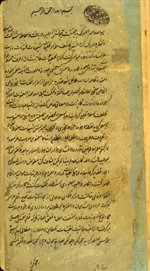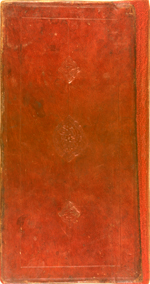Catalogue: Pharmaceutics
-
 Alfaz al-adwiyah (MS P 4)
Alfaz al-adwiyah (MS P 4) - (Pharmacological Dictionary)
- الفاظ الادويه
- by Nūr al-Dīn Muḥammad ‘Abd Allāh ibn ḥakīm ‘Ayn al-Mulk Qurayshī Shīrāzī (fl. mid-17th century)
- نور الدين محمد عبد الله ابن حكيم عين الملك قريشى شيرازى
The treatise was dedicated to the Mughal Emperor Shah Jahan in the first year of his reign. The title of the treatise forms a chronogram giving the year of composition as 1038 (= 1628-9).
The pharmacological dictionary is divided into an introduction (muqaddimah), an alphabetical list (natijah) of medieval medicaments, and a conclusion (khatimah) on early modern additions to the pharmocopeia consisting of bezoar, bitumen (mumiya'i), China root (chub-i chini), tea, coffee, and tobacco.
An English translation of the treatise was published in Calcutta in 1793: Ulfaz udwiyeh, or The Materia Medica, in the Arabic, Persian, and Hindevy languages. Compiled by Noureddeen Mohammad Abdullah Shirazy ... with an English translation by F. Gladwin, Calcutta, 1793.
For other copies, see Storey PL II,2, pp. 255-8, and Keshavarz, "Wellcome", p. 78.
Alfaz al-adwiyah (MS P 4)
Illustrations
The opening of a Persian pharmacological dictionary composed in 1628/1038 by Nūr al-Dīn Muḥammad ‘Abd Allāh Shīrāzī. The treatise was dedicated to the Mughal Emperor Shah Jahan. The copy was made in 1719/1131. Near the top is an impression of an oval owner's stamp bearing the name ‘Abd [Allāh] Muḥammad ibn Muḥammad ‘Alī and dated 1268 (= 1851). The manuscript is made of paper dyed blue. The outer edge of the folio has been repaired with a very brighter blue paper.
The binding has covers made of red leather over pasteboards, decorated with a central ovate blind-stamped medallion and two pendants. There is a vertical central line and a thin frame of a single fillet. This design is then enclosed by another frame formed of two fillets.
Physical Description
Persian. 118 leaves (fols. 1b-118a). Dimensions 21.7 x 10.4 (text area 16.3 x 7.3) cm; 20-21 lines per page. The title is given on title page (fol. 1a) and in the colophon (fol. 118a line 19). The author is given on fol. 3b, line 2, as Nūr al-Dīn Muḥammad ‘Abd Allāh ibn ḥakīm ‘Ayn al-Mulk Shīrāzī. The dedication to Shah Jahan is given on fol. 3a, line 11.
The copy is dated in colophon (fol. 118a lines 19-20): 24 Rabi‘ I [11]31 (= 14 February 1719); the first two numerals of the year are illegible because of worming, and the numeral 3 is not clearly written. The copyist is named, but only part of his name, Ibrāhīm, is readable.
A complete copy.
The text is written in a small ta‘liq script in black ink with headings in red and red overlinings. There are catchwords.
There are marginalia in several hands, some of it rather extensive. There are miscellaneous later jottings on the preliminary folio [1a].
The glossy, thin paper is dyed various shades of blue and pink; it has only laid lines visible. The paper is very wormeaten. A number of folios have been repaired and strengthed, and all the edges have been trimmed from their original size. The paper of the preliminary folio [1] and the end leaf [fol. 119] is thick watermarked paper of a later date.
The volume consists of 118 leaves, with one preliminary leaf and one end leaf [119]. Fol. 118b is blank and fol. 1a is blank except for the title written in a later hand. Preliminary folio [1]a has unrelated miscellaneous notes by a later owner, with the verso (prelim folio [1]b) blank. The end leaf, fol. [119], has been bound in upside-down; it has three unrelated notes in different later hands.
Binding
The volume is bound in red leather over pasteboards, both covers decorated with blind stamped medallions and two small devices enclosed in thin frames. The spine and edges have been repaired with red leather. There are paper pastedowns of the same paper as used for the preliminary and end leaf [119]; there are some notes written on them, partially defaced. There are modern endpapers.
Provenance
On fol. 1b there is the impression of an oval owner's stamp with the name ‘Abd [Allāh] Muḥammad ibn Muḥammad ‘Alī and dated 1268 (= 1851), and on fol. 118a there is a light impression of a different, undated, oval stamp with a name possibly reading ‘Alī ibn Muḥammad ibn ‘Alī.
The volume was in the collection of the Army Medical Library in 1946. Further information on provenance is unavailable.
References
Schullian/Sommer, Cat. of incun. & MSS., entry P 4, pp. 330-1, where the manuscript is described as undated and probably of the 16th century.
NLM Microfilm Reel: FILM 48-131 no. 2












